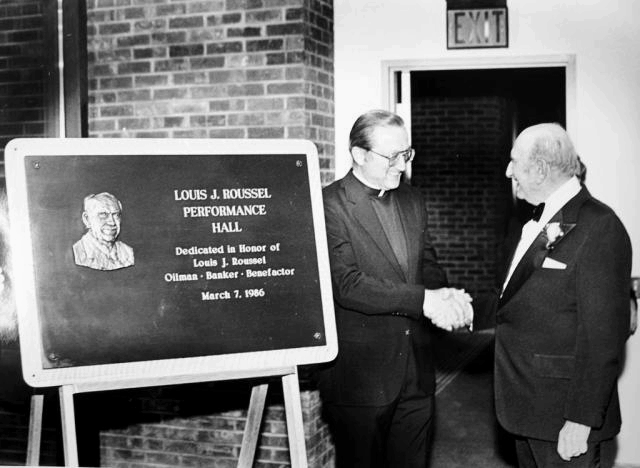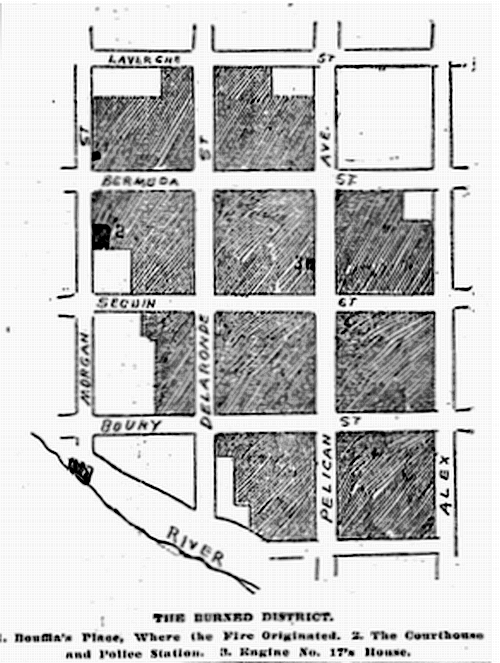|
Today in New Orleans History |
|
|
October 20
October 20, 2001 
Father James Carter, S.J., greeting Louis J. Roussel Jr. in 1986 at the opening of the Louis J. Roussel Performance Hall, a 600-seat hall that can handle a full spectrum of performances from solo recitals to full symphony orchestra concerts. Source: Loyola Archives
Louis J. Roussel Jr., born on July 28, 1906, was a streetcar conductor who made a fortune in petroleum and banking. He was
known for his long-time financial support to the campaigns of Edwin Washington Edwards, lieutenant governor Bill Dodd, State
Senator Ben Bagert, J. Bennett Johnston Jr.,and others. Roussel contributed a total of $500,000 to Dodd's campaigns and $600,000
alone to Edwards' failed 1987 race against Buddy Roemer. In 1997 Roussel published his autobiography,
Friends, Enemies & Victims - The Personal Success of a Seventh-Grader: The Autobiography of Louis J. Roussel,
Jr.. . A resident of Metairie, he died on October 20, 2001 at the age of 95 and is buried in Metairie
Cemetery. His name lives at Loyola University's Louis J. Roussel Performance Hall and the Louis J. Roussel, Jr. Laser Planetarium
and MegaDome Cinema in Kenner.
October 20, 1997 Eugene D. Cizek, Architect submitted plans for new construction at the home of Hollywood Director Francis Ford Coppola at 714 Governor Nicholls Street. For a time, Coppola used the building as a seven-room luxury hotel. As of October 2013 he uses it as his residence.
Born on September 26, 1918, Fred James Cassibry received a B.A. from Tulane University
in 1941 and an LL.B. from Tulane Law School in 1943. After serving in the Navy during World War II he became a field examiner
for the National Labor Relations Board from 1946 to 1948. He entered private practice in New Orleans from 1948 to 1961, and
was a New Orleans City Councilman from 1954 to 1961. He was a judge on the Civil District Court for Orleans Parish from
1961 to 1966. On October 11, 1966, Cassibry was nominated by President Lyndon B. Johnson to a new seat
on the United States District Court for the Eastern District of Louisiana created by 80 Stat. 75. He was confirmed by the
United States Senate on October 20, 1966, and received his commission on November 3, 1966. He assumed senior status on March
15, 1984, serving in that capacity until his retirement on April 3, 1987. He died on July 6, 1996.
Ferdinand Joseph LaMothe (?October 20, 1890? – July 10, 1941),
known professionally as Jelly Roll Morton, was an American ragtime and early jazz pianist, bandleader and
composer who started his career in New Orleans, Louisiana. Morton was born into a Creole of Color family in the Faubourg Marigny neighborhood of downtown New Orleans, Louisiana.
Sources differ as to his birth date: a baptismal certificate issued in 1894 lists his date of birth as October 20, 1890;
Morton and his half-sisters claimed he was born on September 20, 1885.
His World War I draft registration card showed September 13, 1884, but his California death certificate listed his birth
as September 20, 1889. He was born to F. P. Lamothe and Louise Monette (written as Lemott and Monett on his baptismal certificate).
Eulaley Haco (Eulalie Hécaud) was the godparent. Hécaud helped choose his christening name of Ferdinand. His
parents lived in a common-law marriage and were not legally married. No birth certificate has been found to date. Widely
recognized as a pivotal figure in early jazz, Morton is perhaps most notable as jazz's first arranger, proving that a genre
rooted in improvisation could retain its essential spirit and characteristics when notated.
His composition "Jelly Roll Blues" was the first published jazz composition, in 1915. Morton is also notable for
naming and popularizing the "Spanish tinge" (habanera rhythm and tresillo), and
for writing such standards as "Wolverine Blues", "Black Bottom Stomp",
and "I Thought I Heard Buddy Bolden Say", the latter a tribute to New Orleans personalities from the turn of the
19th century to 20th century. Reputed for his arrogance and self-promotion as often as recognized in his day for his musical
talents, Morton claimed to have invented jazz outright in 1902 — much to the derision of later musicians and critics. The jazz historian, musician, and composer Gunther Schuller says of Morton's
"hyperbolic assertions" that there is "no proof to the contrary" and that Morton's "considerable
accomplishments in themselves provide reasonable substantiation".
However, the scholar Katy Martin has argued that Morton's bragging was exaggerated by Alan Lomax in the book Mister Jelly
Roll, and this portrayal has influenced public opinion and scholarship on Morton since. From http://en.wikipedia.org/wiki/Jelly_Roll_Morton
On Saturday, April 30, 1803, the Louisiana Purchase Treaty was signed by Robert Livingston,
James Monroe, and Barbé Marbois in Paris. Jefferson announced the treaty to the American people on July 4. After
the signing of the Louisiana Purchase agreement in 1803, Livingston made this famous statement, "We have lived long,
but this is the noblest work of our whole lives...From this day the United States take their place among the powers of the
first rank." The United States Senate ratified the treaty with a vote of twenty-four to seven on October
20, 1803. The Senators who voted against the treaty were: Simeon Olcott and William Plumer of New Hampshire, William
Wells and Samuel White of Delaware, James Hillhouse and Uriah Tracy of Connecticut, and Timothy Pickering of Massachusetts.
On the following day, the Senate authorized President Jefferson to take possession of the territory and establish a temporary
military government. In legislation enacted on October 31, Congress made temporary provisions for local civil government
to continue as it had under French and Spanish rule and authorized the President to use military forces to maintain order.
Plans were also set forth for several missions to explore and chart the territory, the most famous being the Lewis and Clark
Expedition. France turned New Orleans over on December 20, 1803 at The Cabildo. On March 10, 1804, a formal ceremony was conducted
in St. Louis to transfer ownership of the territory from France to the United States. Effective on October 1, 1804, the purchased
territory was organized into the Territory of Orleans (most of which became the state of
Louisiana) and the District of Louisiana, which was temporarily under the control of the governor and judges of the Indiana
Territory. (Wiki)
|
||
|

To receive an update for each day in New Orleans history,
join our facebook page - Today in New
Orleans History.
Analytics |






